Useful Products for Parents with Toddlers Who Touch Everything
Toddlers are in that magical (and slightly terrifying) stage of life where everything is new, exciting, and worth touching—including sharp corners, cabinet doors, electrical outlets, dog bowls, and basically anything that isn’t meant for them. If you’re parenting through this stage, you’ve probably noticed two things:
They move fast.
They find everything.
This is completely normal. Around ages 1 to 3, children go through rapid brain development. They’re hardwired to explore with their senses, especially through touch. It’s how they learn textures, shapes, temperatures, and cause-and-effect. But as cute as this curiosity is, it also comes with a lot of safety concerns and messes—from bumped heads to spilled snacks and finger-painted walls (with food, not paint).
That’s why it’s important to set up your home to match their stage, not the other way around. You don’t need a total redesign—just the right tools in the right spots. A few smart changes can help you:
Prevent injuries before they happen
Reduce cleanup stress (because there will be spills)
Encourage safe independence, like self-feeding or learning to tidy up
Stay more organized, even when it feels like a tornado hit the toy bin
This guide is built for real parents dealing with real toddler chaos. We’re going to walk through key problem areas—like sharp furniture edges, unlocked cabinets, mealtime disasters, and everyday clutter. For each one, you’ll find practical product suggestions and mini reviews that focus on what actually works. No hype, no fluff, just gear that makes life a little easier.
Parenting a toddler is loud, messy, and completely unpredictable. But with the right setup, you can make your home safer, cleaner, and just a bit more peaceful—without trying to control your toddler’s curiosity (because let’s face it, that’s impossible).
Safety First – Protecting Curious Hands
Toddlers don’t know what’s dangerous. To them, opening a cabinet under the sink is just as fun as playing with blocks—and climbing furniture seems like a great idea until gravity kicks in. That’s why safety is one of the first things parents need to tackle once a child becomes mobile.
The average home has dozens of hidden hazards that adults barely notice anymore. Sharp corners, exposed cords, breakable items on low shelves, cleaning supplies within reach—these can quickly turn a quiet moment into a trip to the emergency room. And since toddlers move fast (and often silently), prevention beats reaction every time.
Here are the most common problem zones to watch for:
Furniture with sharp edges. Coffee tables, nightstands, and low shelves often sit right at toddler head level. Bumped foreheads are common—and preventable.
Cabinets and drawers. From knives to detergents to just making a mess, toddlers love to open everything. Locking things up can avoid danger and frustration.
Electrical outlets. They’re exactly at toddler eye level and look fascinating. Even if unused, they need protection.
Toilets and trash cans. Water play and mystery items? Toddlers don’t see a problem here—but you might.
Furniture tipping. Climbing on drawers, bookshelves, or even a TV stand can lead to serious injuries.
Creating a safer environment doesn’t mean bubble-wrapping the entire house. It’s about identifying the spots where accidents are most likely to happen and adding small barriers or reinforcements. The goal isn’t to stop exploration—it’s to make sure your toddler can explore without getting hurt.
Another helpful tip: get on the floor and look around from their level. What’s tempting? What’s within reach? You’ll be surprised what you notice from two feet off the ground.
In the next part, we’ll go over a few simple tools that can help prevent the most common bumps, bruises, and scares—without making your home feel like a padded cell.
RovingCove Baby Proofing Edge & Corner Guards
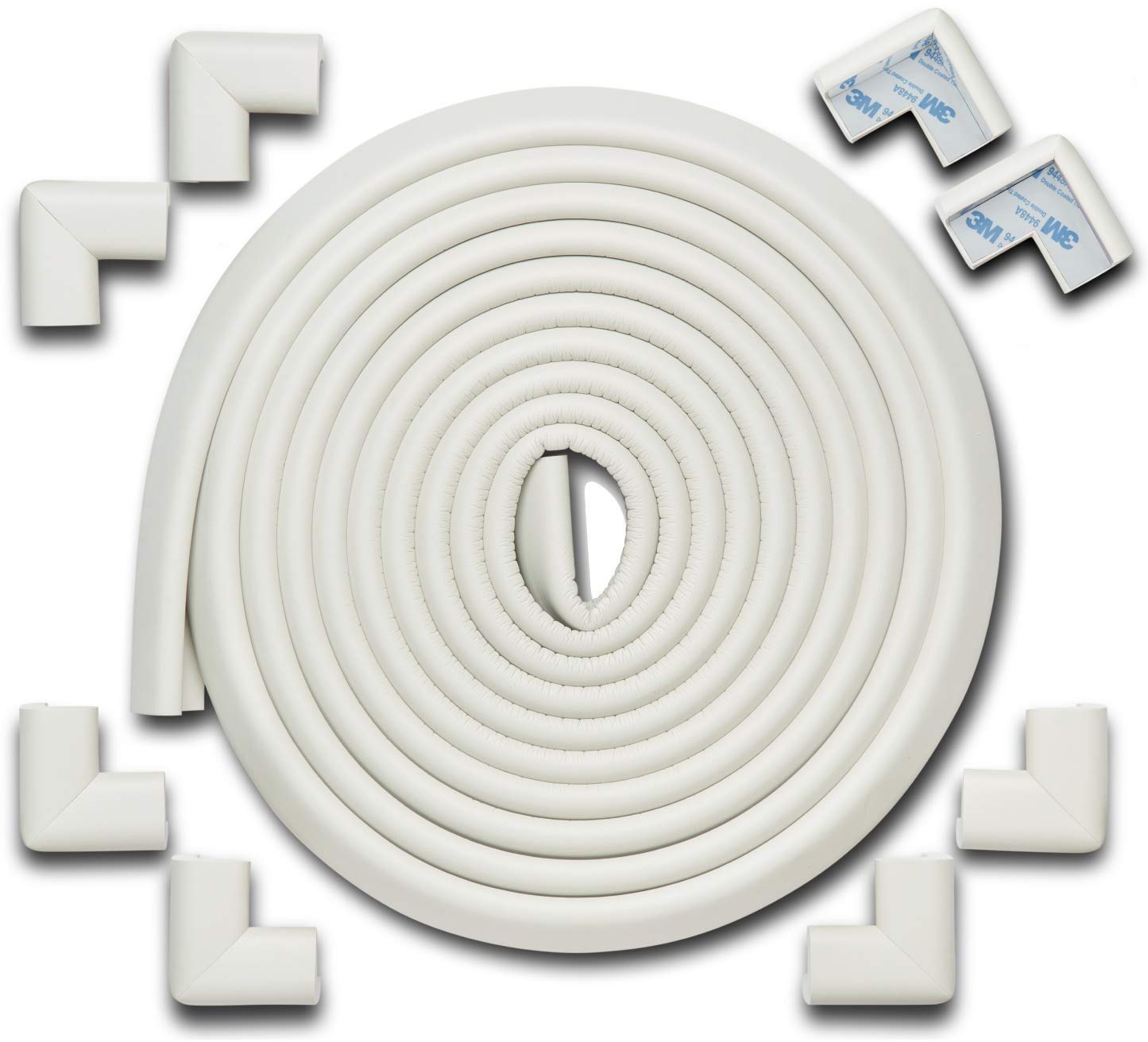
Toddlers are wobbly, fast, and often completely unaware of danger—which makes hard furniture edges one of the most common injury risks at home. The RovingCove Edge & Corner Guard Set is designed to cushion sharp corners and edges with dense foam padding, helping reduce the severity of bumps and falls during the clumsy years.
What sets this kit apart from standard clear silicone guards is that it includes 16.2 feet of edge padding and 8 corner guards, offering full coverage for an entire table, countertop, or low shelf. The foam is phthalate-free, BPA-free, and latex-free, which is especially important if your toddler tends to mouth everything in sight. It’s also fire-retardant, which adds a layer of peace of mind, especially in areas near electronics or heaters.
The included 3M double-sided adhesive holds up well if applied correctly—just make sure to clean the surface thoroughly and press down for at least 30 seconds. It’s best to let the adhesive cure for several hours before letting your child near it. Once installed, the foam stays in place even with curious hands pulling at it, yet it can still be removed later without damaging most surfaces.
This product works well for square-edged tables, bed frames, fireplace ledges, and even awkward furniture like toy chests or window sills. However, because the foam is thicker and more visible than minimalist silicone bumpers, it’s more suited for high-risk areas than decorative furniture.
If you’re looking for maximum impact protection—especially in active households or homes with multiple toddlers—this is one of the most complete and reliable kits available.
Vmaisi Adhesive Magnetic Cabinet Locks
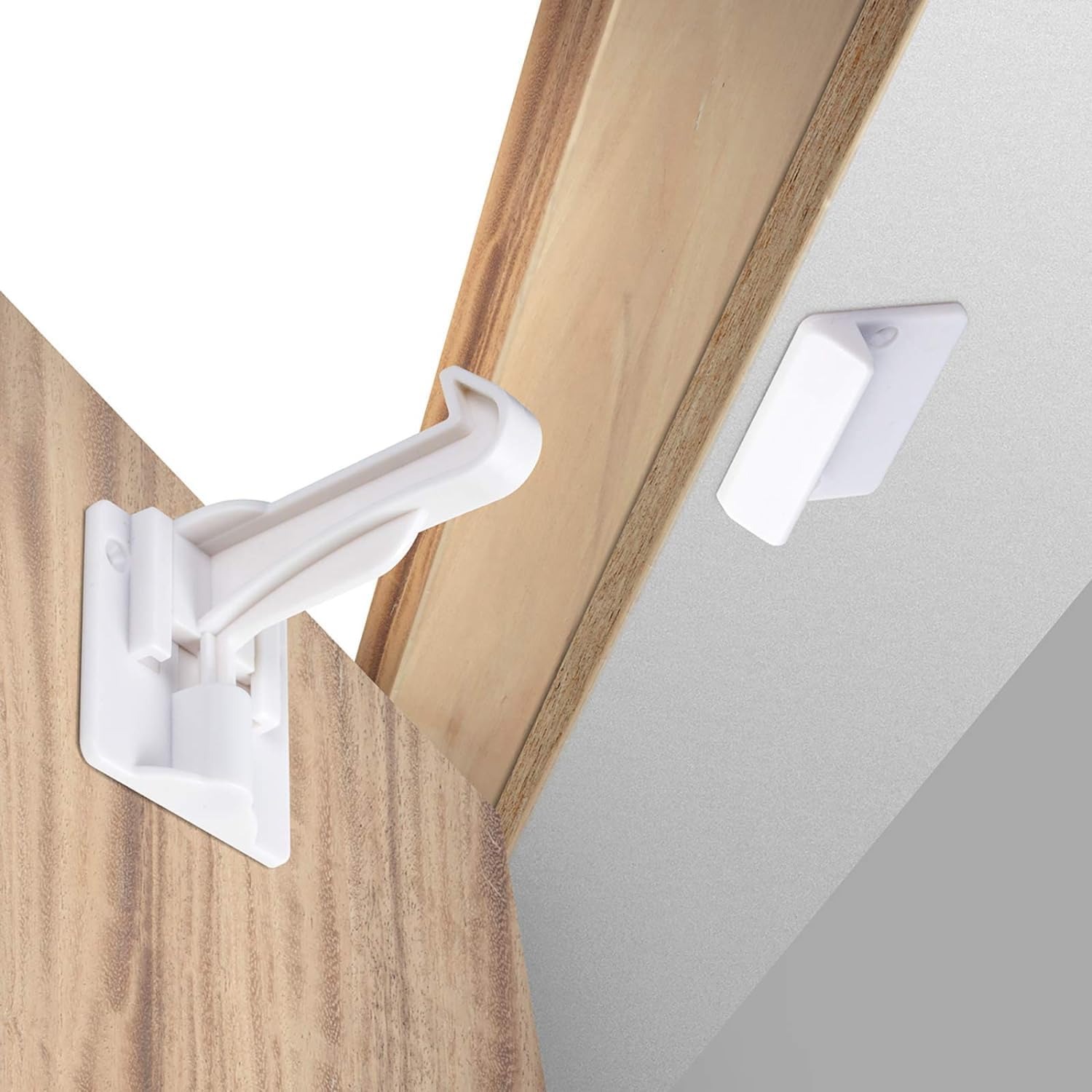
Once toddlers learn to open drawers and cabinets, every room becomes a new adventure—often with dangerous results. The Vmaisi Magnetic Cabinet Locks are a discreet way to keep them out of places they shouldn’t be, like cleaning supply cabinets, medicine drawers, or pantry shelves.
These locks mount to the inside of the cabinet or drawer, so there’s no visible latch or strap on the outside. They function using a small magnetic key that disables the lock when held in the right spot. This system makes it extremely difficult for children to figure out, while still allowing adults to open things quickly with one hand.
Installation is relatively simple, even without tools. The locks come with pre-applied 3M adhesive, which means no screws or drilling. A positioning template is included, helping line up each lock and latch properly. The bond holds well on smooth, clean surfaces like laminate or sealed wood. For textured or worn cabinets, you may need to press firmly and let the adhesive cure overnight.
Each unit also includes a small switch that can temporarily disable the lock when it’s not needed—for example, during meal prep or when kids are sleeping. This is useful if you want to leave some cabinets unlocked for periods of time without uninstalling the entire system.
These magnetic locks are a great choice for parents who want an invisible safety solution that blends into their kitchen or bathroom. However, the magnetic key is easy to misplace, so it helps to mount a spare inside a high cupboard or on the fridge using an adhesive hook.
The set includes 12 locks and 2 keys, making it a good fit for homes with multiple access points to secure.
Eating Without the Explosion – Taming Mealtime Mayhem
Mealtime with toddlers can feel less like a bonding ritual and more like a full-contact sport. From yogurt-smeared cheeks to cereal dumped all over the floor, it’s clear: they’re learning, but it’s messy. And that’s okay—learning to feed themselves is a major milestone. But it doesn’t mean your floors, tables, or sanity have to suffer.
Toddlers at this stage are developing fine motor skills, so spills, drops, and thrown food are all part of the process. While you can’t eliminate the mess entirely, you can set things up to make cleanup easier and reduce frustration for everyone involved.
Some of the most common mealtime struggles include:
Snacks spilled all over the couch or car seat
Bowls flipped over the second your back is turned
Placemats pushed onto the floor before the first bite
Sticky hands touching everything within a 4-foot radius
That’s where well-designed toddler-friendly feeding gear can help. The right tools won’t just contain the chaos—they’ll also encourage your child to eat more independently and feel in control of their own meals (which usually means fewer tantrums). Think: dishes that stay put, cups that don’t leak, and mats that actually stay on the table.
Choosing the right items can make a big difference in how smoothly (and cleanly) each meal goes. In the next part, we’ll go over a few specific products that help reduce spills, limit mess, and give your toddler the freedom to feed themselves—without turning your kitchen into a disaster zone.
Munchkin Snack Catcher
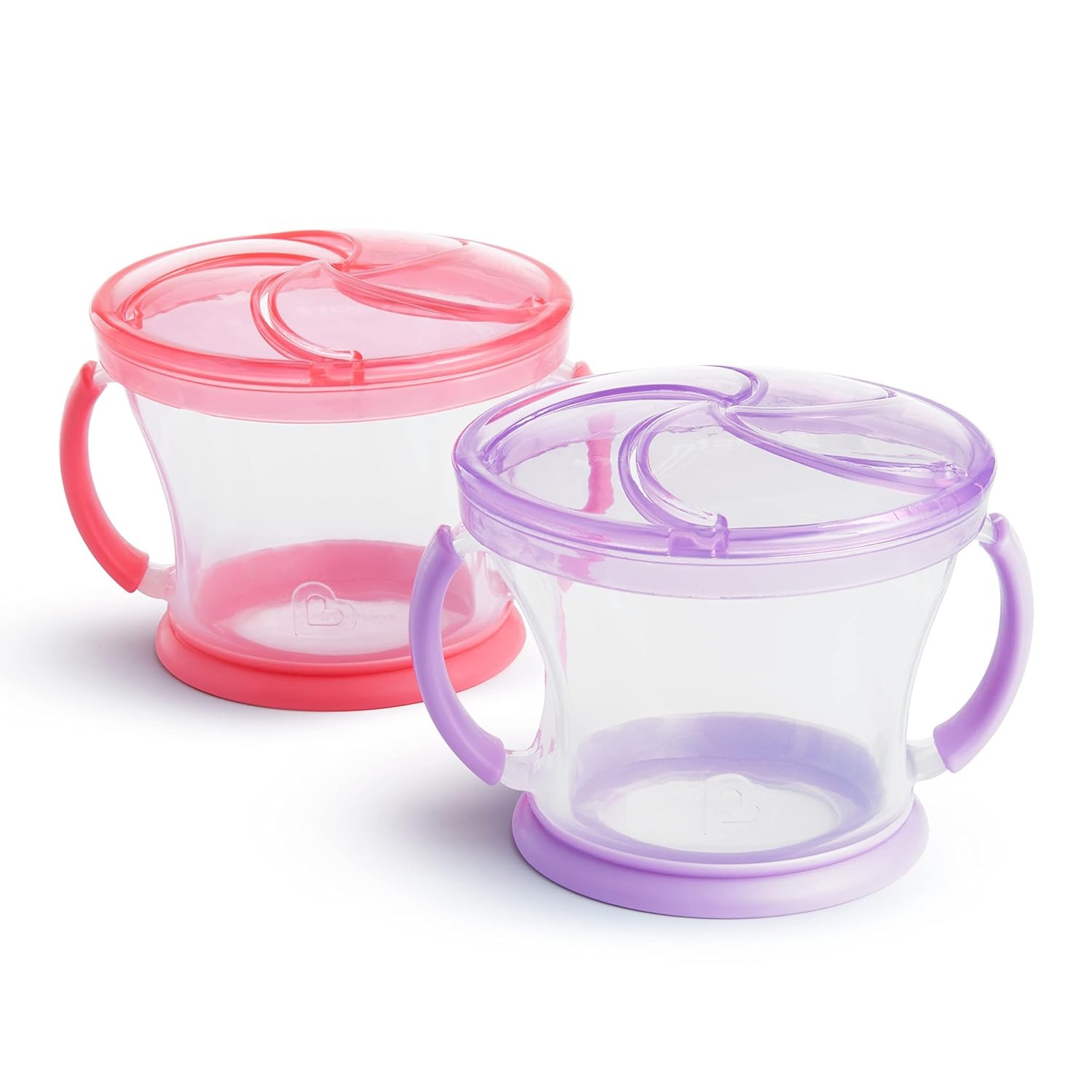
This is one of those small parenting tools that solves a much bigger problem. The Munchkin Snack Catcher helps toddlers feed themselves without scattering crackers, cereal, or fruit bits across every surface of your home (or car).
Each cup has a soft flapped lid that little hands can reach into easily, but that mostly keeps snacks from spilling out if the cup is tipped, shaken, or tossed. It’s not 100% foolproof—nothing is—but it dramatically cuts down on mess. The two-handled design also makes it easy for small hands to grip and carry on their own.
They’re made from BPA-free plastic, dishwasher-safe on the top rack, and hold just enough for a toddler-sized portion—around 9 ounces. That makes it great for short outings or snack time at home. Because it’s lightweight, it also works well in strollers or car seats.
Some parents note that persistent snack-dumpers can still get around the flaps with effort, so it won’t stop determined mischief. But for most toddlers, it slows the mess enough to make snack time manageable.
This two-pack is a good value, especially if you want one for home and one for on-the-go.
EZPZ Mini Mat – All-in-One Silicone Placemat & Plate
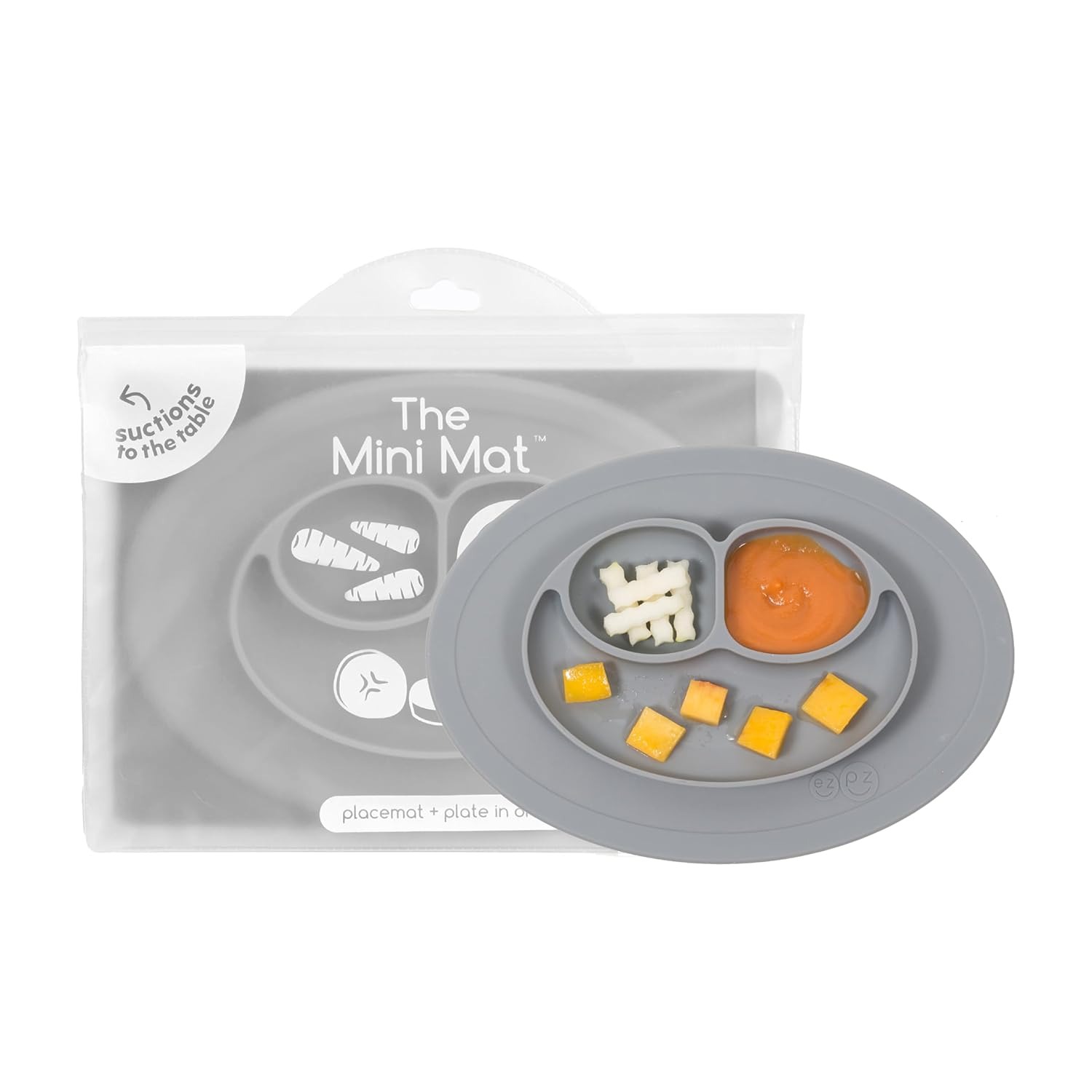
Toddlers love pushing plates off tables. If that’s a regular part of your meals, the EZPZ Mini Mat can save your sanity. It’s a food-grade silicone placemat with a built-in plate, designed to suction to flat surfaces like high chair trays or tables.
Unlike standard mats or dishes, this one doesn’t slide around. Once it’s placed down, it stays put, helping prevent spills and reducing the temptation for your toddler to flip their meal onto the floor. The plate itself is divided into three compartments (great for picky eaters), and the whole thing is made from BPA-, BPS-, and phthalate-free silicone that’s safe for dishwashers, microwaves, and even ovens up to 350°F.
The low-profile design makes it easy to pack for travel or dining out, and it rinses clean with just a quick wipe. It’s especially helpful for kids who are just starting self-feeding and need a stable setup while they build coordination.
One thing to check: the mat needs a completely smooth surface to suction well. It won’t work on textured high chair trays or wood grain tables with deep ridges.
If you’re tired of catching plates mid-air or wiping applesauce off the walls, this is a smart, durable upgrade for everyday meals.
Clean-Up Made Easier – Tools That Save Time and Sanity
There’s no sugar-coating it: life with a toddler is messy. Mealtime spills, sticky fingers, smeared crayons, juice dribbles, sandbox dust—somehow it all ends up on your floors, furniture, clothes, and sometimes the ceiling. You clean one mess, and five minutes later, you’re dealing with another.
The thing is, toddlers are supposed to be messy. It’s part of how they learn. But that doesn’t mean you have to resign yourself to living in a disaster zone. The key is having the right tools on hand—not for deep cleaning, but for quick daily resets that stop the mess from piling up.
Some typical clean-up challenges parents face include:
Crumbs in every corner (especially in the car or couch cushions)
Sticky handprints on every reachable surface
Spilled snacks or drinks that attract ants or get stepped on
Wipe-downs that take longer than the meal itself
Dragging out a full-size vacuum for the tenth time that day
Trying to tackle all of this with standard cleaning gear just isn’t realistic. Toddlers move fast and make a lot of small messes that need fast, flexible solutions—things you can grab quickly, use one-handed, and stash away when not needed.
In this section, we’ll focus on two types of tools that make a big difference:
A portable handheld vacuum for crumbs, dirt, and spills on floors, couches, car seats, and high chair trays
A stash of baby-safe, all-purpose wipes that clean everything from faces to furniture, with no rinse needed
These tools aren’t about deep cleaning or spring cleaning—they’re about keeping your home livable in the middle of the toddler storm. A quick cleanup at the right moment can prevent bigger messes, save your floors, and keep things from feeling overwhelming. And just as importantly, they help you stay calm and focused on your kid, rather than the mess behind them.
BLACK+DECKER Dustbuster AdvancedClean Cordless Handheld Vacuum
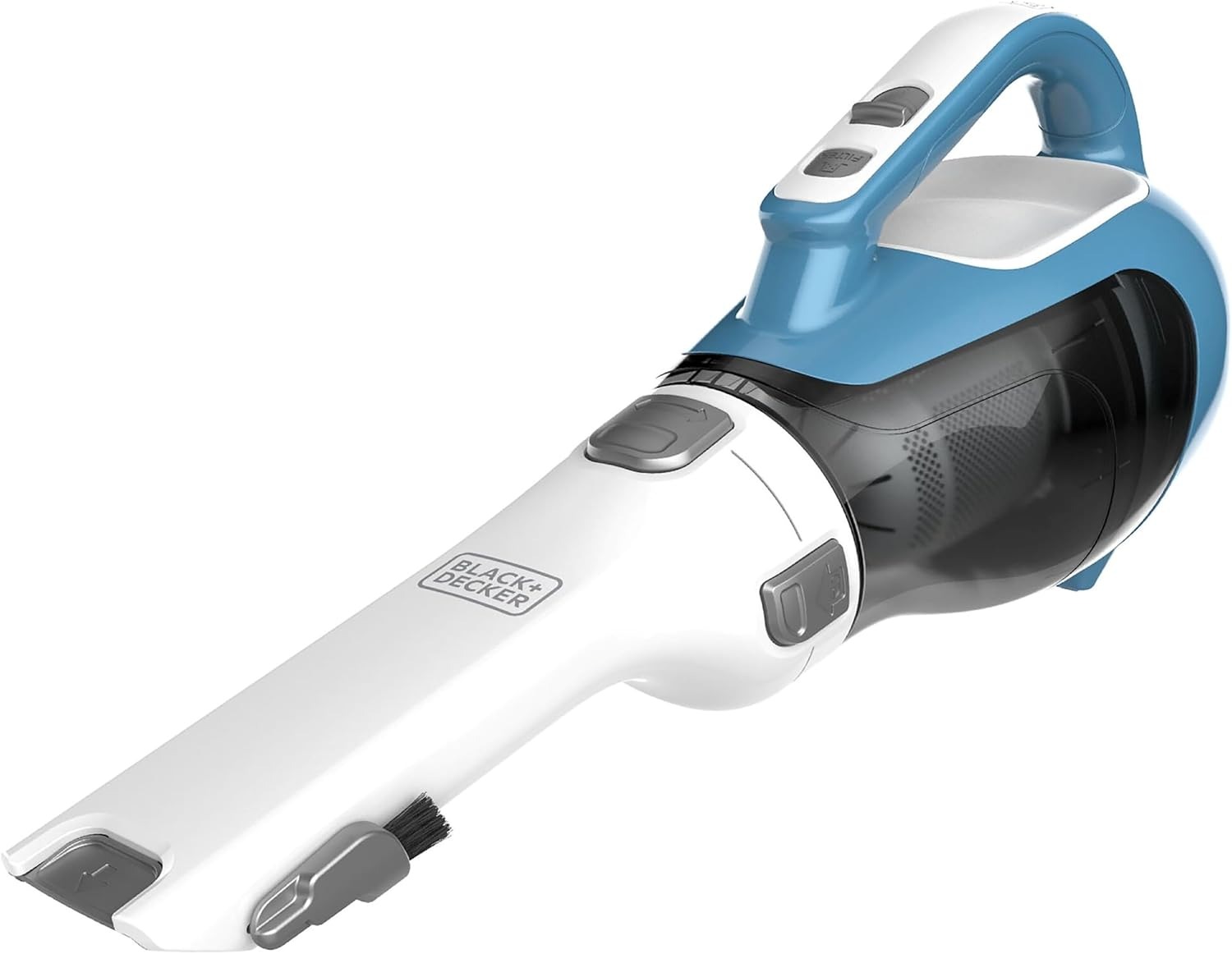
Toddlers leave crumbs everywhere—under the high chair, inside the car seat, between couch cushions, even in their shoes. The BLACK+DECKER Dustbuster AdvancedClean is a compact, cordless handheld vacuum that’s ideal for fast cleanups throughout the day, especially when you don’t want to drag out a bulky vacuum for a small mess.
This model is lightweight (just over 2.5 pounds), easy to grab with one hand, and runs on a lithium-ion battery that holds a charge for up to 18 months when stored—though regular users will be recharging more often. It offers solid suction for a handheld, strong enough to pick up dry cereal, cracker crumbs, sand, and even bits of dried playdough from rugs or floors. The narrow nozzle extends and rotates, so it’s great for getting into tight corners or under toddler chairs without bending down too far.
The dust bowl is bagless and washable, which means no extra filters to buy. Just dump it out, rinse, and snap it back into place. It also comes with a built-in crevice tool and flip-up brush—useful for cleaning high chair edges, car seats, or toy bins.
This isn’t meant for wet messes or pet hair on carpets, but it’s ideal for the type of mess toddlers make 20 times a day. Having this on hand can cut your clean-up time in half and help keep your space from becoming overwhelming.
WaterWipes Original Baby Wipes

There are baby wipes, and then there are WaterWipes—a go-to option for parents who want something truly safe for both skin and surfaces. These wipes are made with 99.9% water and a drop of fruit extract, with no added fragrance, alcohol, parabens, or unnecessary chemicals. That makes them gentle enough to clean sticky toddler hands and faces and safe enough for wiping down toys, high chairs, or even pacifiers in a pinch.
They’re especially good for kids with sensitive skin or conditions like eczema, since they don’t leave behind residue or irritation. Parents also love that they work equally well on non-skin messes—spilled milk on the floor, apple sauce on the couch arm, or food stuck to stroller trays.
Each pack opens easily with one hand, and the wipes come out one at a time (which helps when your other hand is holding a squirming child). They’re not as wet or heavily perfumed as some other brands, which makes them faster to dry and better for light surface cleaning. While they’re not a substitute for disinfecting wipes, they’re perfect for day-to-day messes where safety and convenience matter more than deep sanitizing.
Stocking up in bulk (like the 720-count box) is useful if you keep a pack in multiple places: diaper bag, car, kitchen, and bedroom. You’ll reach for them more often than you think.
Organize the Chaos – Keeping Toddler Gear in Check
If you’ve ever stepped on a toy car at 6 a.m. or spent 10 minutes digging through a diaper bag for wipes that somehow vanished, you know that toddlers come with a lot of stuff. Snacks, cups, shoes, wipes, crayons, spare clothes, favorite toys (plural), books, sippy cups… and somehow all of it ends up in the wrong place.
When your child is under three, keeping your space organized isn’t about being tidy for the sake of appearances. It’s about functionality and saving your own energy. If you can find what you need without digging through a pile of mystery items—or stop toys from migrating into the bathroom—you’ll feel less overwhelmed and more in control.
Here are some of the most common pain points:
The car becomes a second playroom, with half-eaten pouches under the seat and missing shoes under the passenger side
Toys end up scattered across every room, including the kitchen and hallway
Essential items like wipes, sunscreen, or pacifiers disappear when you need them most
Diaper bags get cluttered with “just in case” items, making them heavy and hard to use
Toddlers don’t care about neatness (and shouldn’t be expected to), so it’s up to parents to create systems that work with their habits—not against them. That means using simple containers, dividers, and travel-friendly organizers that keep everything within reach but out of the way.
In this section, we’ll look at two helpful tools: a backseat organizer that turns chaotic car rides into something a little more functional, and a set of stackable toy bins with lids that can help reclaim your living room without fighting a daily battle over clutter.
Both of these are easy wins. They don’t require major changes, just a bit of setup—and the payoff is huge in terms of time saved and daily stress reduced.
Lusso Gear Backseat Car Organizer with Tablet Holder
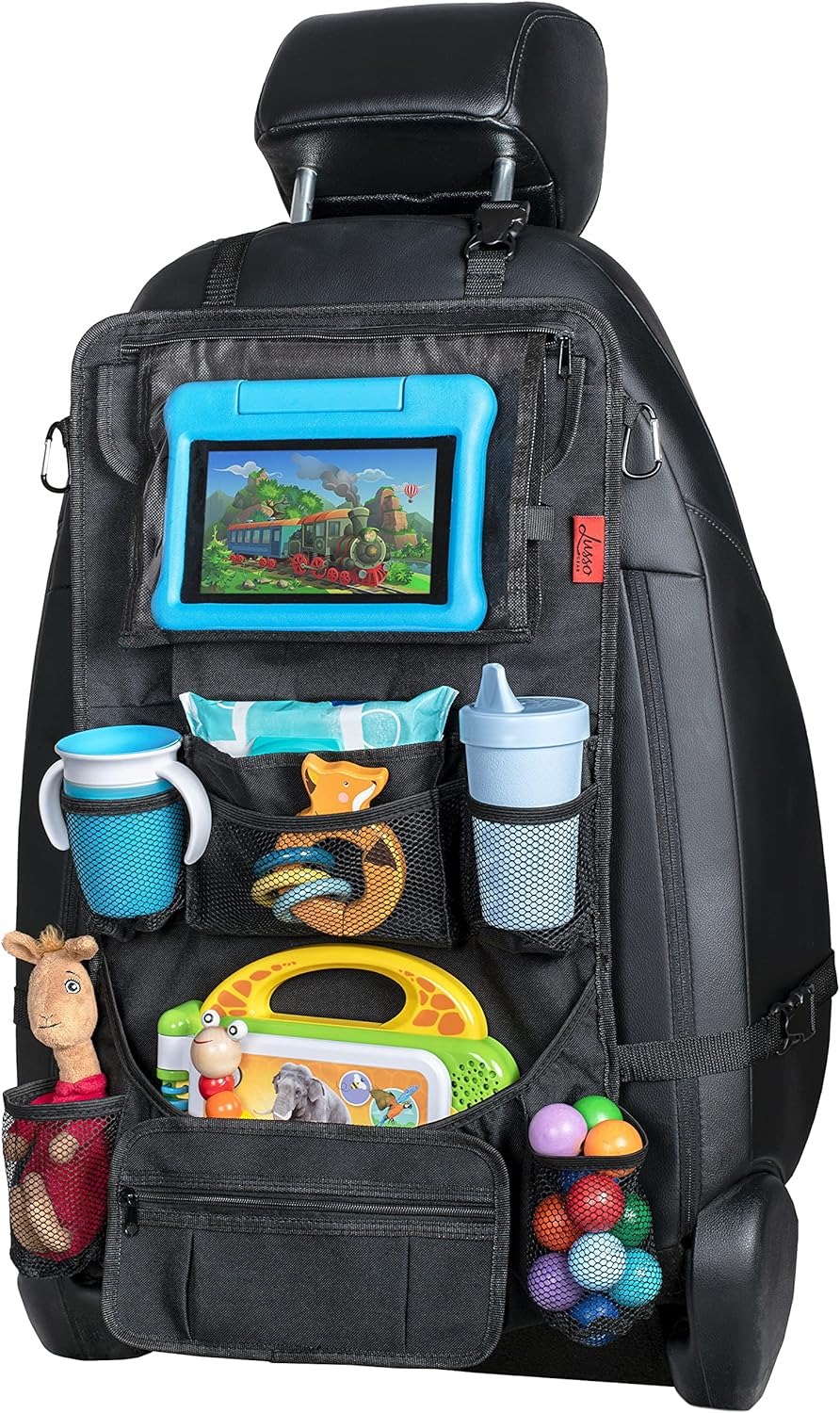
If your toddler turns car rides into snack explosions and toy treasure hunts, the Lusso Gear Backseat Organizer can make a real difference. Designed to hang on the back of the front seat, this organizer has multiple compartments, including mesh pockets, deep pouches, cup holders, and even a clear tablet holder for screen time on long drives.
What makes it useful is how much it can hold without sagging or sliding around. Parents typically use it to store wipes, books, sippy cups, extra diapers, small toys, and even a change of clothes. The touchscreen-friendly tablet holder is a bonus—it keeps the device secure and visible, but out of sticky reach. The clear plastic is surprisingly responsive, so videos or apps can still be used without removing the device.
Made from durable Oxford fabric, it wipes clean easily, and installation is simple with adjustable straps that fit over most car seat headrests. Once it’s set up, you don’t need to think about it again—everything just has a place. It also works well in ride-share setups or travel rentals if you’re flying with kids and need a portable organization solution.
While it won’t stop your toddler from launching a snack across the backseat, it does help reduce the number of items rolling around the floor or getting stuck between seats.
Humble Crew Extra-Large Toy Organizer with Storage Bins
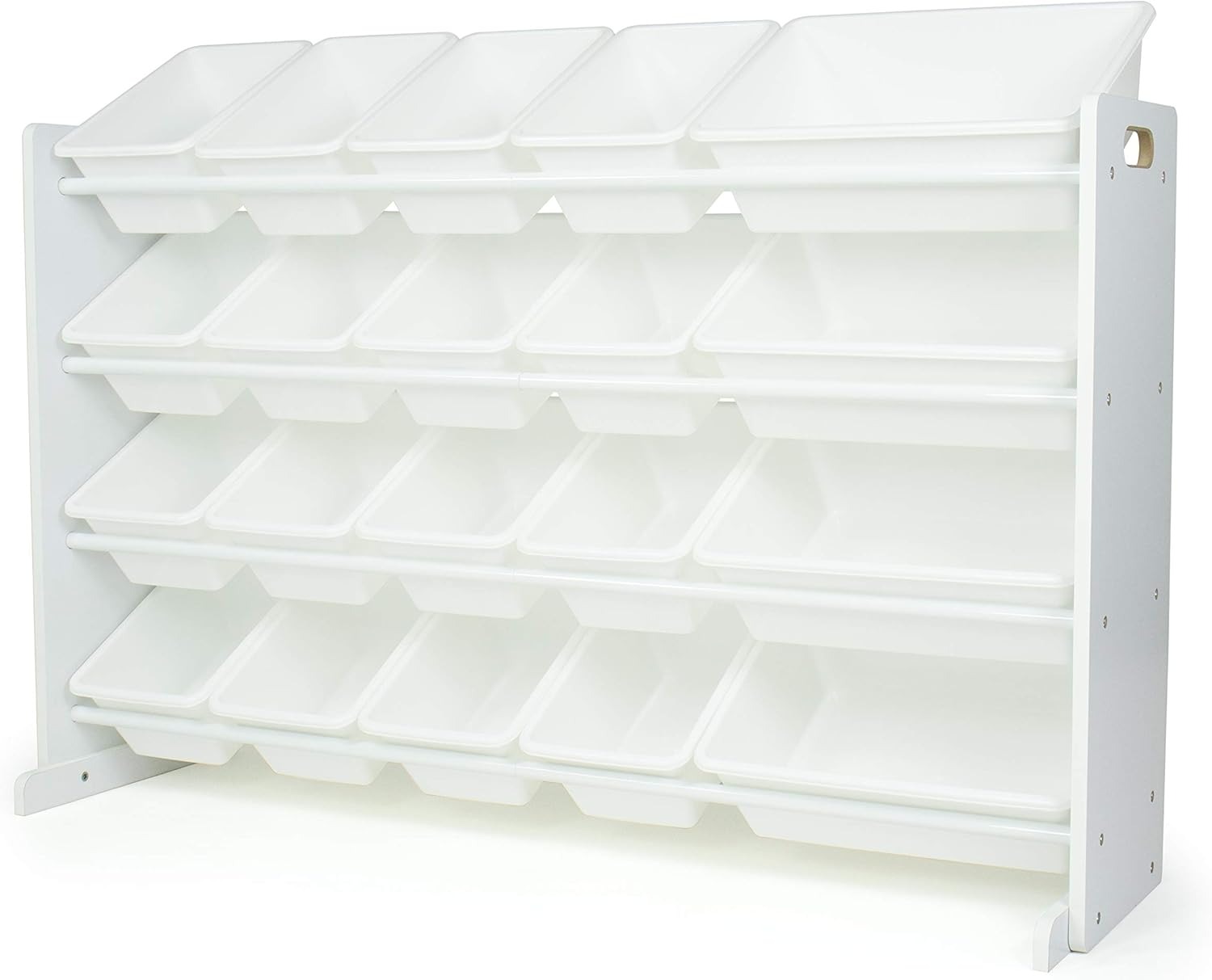
Toys spread fast. If your toddler’s favorite game seems to be “dump everything out and walk away,” a structured storage setup like the Humble Crew Toy Organizer can save your floor space—and your nerves. This particular model includes 16 plastic bins in two sizes, arranged on a tilted shelf that keeps everything visible and accessible.
It’s sized perfectly for toddlers, meaning your child can start learning how to help put things away without needing your constant involvement. The open bins make it easier for them to see what’s inside, which can reduce the chaos that comes from digging through closed containers.
The bins are removable, so your child can take one to another room and (ideally) return it later. They’re made from lightweight plastic that’s easy to wipe down, and the frame is sturdy enough for regular daily use. The color-coded design isn’t just for fun—it can also help with sorting (books go in blue, blocks in green, etc.) if you’re trying to teach basic organization skills.
Assembly is simple—just a few screws and you’re done. If your goal is to reduce toy clutter without constantly stepping on things, this is one of the easiest and most affordable systems to set up.
This organizer works well in living rooms, bedrooms, or play corners, and it’s especially useful if you rotate toys and want to keep only part of your collection visible at a time.
FAQ
How early should I start childproofing?
It’s smart to start before your toddler begins crawling or pulling up to stand, which often happens around 6 to 9 months. Babies move faster than expected, and once they start, they won’t stop. Even a few safety basics—like outlet covers and corner guards—can prevent a lot of avoidable accidents.
If your child is already mobile, it’s not too late. Just focus on the most urgent areas first: cabinets with dangerous items, sharp furniture corners, and anything climbable.
Do I need to childproof every room?
Not necessarily. The key is to childproof any area your toddler uses regularly or has easy access to. For some families, that’s just the kitchen and living room. For others, it includes bathrooms, bedrooms, and even outdoor spaces. Start with the spaces where your child spends the most unsupervised time (even if just for 30 seconds).
Also consider blocking off rooms entirely using baby gates if you’d rather limit access than modify everything.
How many of these safety and cleanup products do I really need?
It depends on your space and routine. You don’t need to buy everything at once. A good starting setup might include:
1–2 types of childproof cabinet locks
Corner guards for sharp-edged furniture
A silicone placemat or suction plate
A spill-proof snack cup for travel
A small vacuum or broom you can grab quickly
Wipes in several key spots (kitchen, car, diaper bag)
Over time, you’ll figure out which items make a difference in your daily routine—and which ones just take up space.
Are these things reusable for a second child?
Most of them are, yes. Items like toy organizers, car seat organizers, and even some cabinet locks (especially magnetic ones) can last through more than one child. Adhesive-based safety tools may need to be replaced, depending on how cleanly they come off and how long they’ve been installed.
Reusable items made of silicone, plastic, or fabric tend to hold up well—especially if cleaned and stored properly.
How do I keep all this gear from taking over my home?
This is a real struggle. The best strategy is to keep gear where you use it most. For example, wipes near the high chair, snacks in a car organizer, and toys in a single central area with labeled bins. Choose storage options that match your space—vertical organizers in small rooms, stackable bins in closets, and portable items (like a diaper caddy) that can move with you.
And remember: you don’t have to keep every item out all the time. Rotating toys or supplies every few weeks can reduce clutter and make old things feel new again for your child.
What’s the best way to encourage my toddler to clean up after themselves?
Toddlers won’t clean like adults, but they can definitely start learning habits. Keep expectations low and the system simple—open bins, low shelves, and visible storage help. Turn it into a game (“Let’s see how fast we can put the blocks in the red bin!”) and model the behavior without pressure. Cleanup songs and visual cues (like picture labels on bins) also help toddlers understand where things go.
The goal isn’t a perfect room—it’s teaching that putting things away is part of play.
Are all “toddler-safe” products actually safe?
Not always. Labels like “baby-proof” or “child-safe” don’t mean much unless backed by actual materials testing. Look for products that are BPA-free, phthalate-free, and independently safety tested. For anything involving food or skin contact, checking reviews and certifications can help avoid cheap or untested knockoffs. And always test safety gear yourself—tug on cabinet locks, check suction mats, and inspect straps regularly.
If something seems flimsy or doesn’t hold up to basic use, it’s probably not safe enough.
What should I do with gear we no longer use?
Once your toddler outgrows certain gear (like cabinet locks or snack cups), consider donating it, passing it to friends or family, or storing it for a future child. Some items—like foam bumpers or adhesive locks—may not be reusable after removal, but others like organizers, dishes, and storage bins can easily find a second life.
If something can’t be reused or given away, check if the materials are recyclable in your area. Keeping clutter down also makes your space more toddler-friendly.
Conclusion
Raising a toddler is a constant balancing act. One minute you’re laughing at their curiosity, the next you’re wiping peanut butter off the wall or pulling toy parts out from under the couch. This phase of life is full of learning—not just for your child, but for you, too. And while you can’t prevent every mess or meltdown, you can set up your environment to make things a lot more manageable.
The truth is, toddlers will always touch, climb, spill, and scatter. It’s how they explore. The goal isn’t to stop them—it’s to create a space where they can do all those things safely and with a little less chaos. That’s where the tools and products we covered come in:
Corner guards and cabinet locks help reduce everyday injuries without turning your home into a fortress
Snack cups and silicone mats let your child feed themselves without destroying your kitchen
Handheld vacuums and gentle wipes make cleanup fast and simple so you don’t waste time on every spill
Organizers and bins turn clutter into something that’s at least somewhat under control
None of these tools will magically make parenting easier—but they’ll take the edge off the daily mess. They buy you back small bits of time and energy. And when you’re dealing with toddler-level intensity, that makes a big difference.
You don’t need to buy everything at once or strive for perfection. Even one or two small changes—like a reliable snack cup or a car seat organizer—can improve your routines and lower your stress levels. The goal is not to control your child, but to support their development in a safer, calmer space.
Every parent’s setup will look different, but the need is the same: keep your child safe, support their independence, and keep your own life from becoming a series of cleanup marathons. The right tools don’t replace parenting—but they definitely help you catch your breath between the wild moments.
And if today felt like a mess? That’s normal. Tomorrow’s a new day—and now you’ve got a few things in your corner to help.
